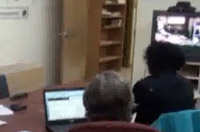Videoconferencing
 Videoconferencing refers to using broadband networks to connect people with video and audio in real time. Usually the set-up looks like talking to a person or persons in one or several distant locations on a television screen. In general, videoconferencing is used as an alternative to travel. It allows people to connect and see facial expressions and body language that is not available through other forms of communication such as telephone or email. For this reason, videoconferencing can help facilitate trust when communicating.
Videoconferencing refers to using broadband networks to connect people with video and audio in real time. Usually the set-up looks like talking to a person or persons in one or several distant locations on a television screen. In general, videoconferencing is used as an alternative to travel. It allows people to connect and see facial expressions and body language that is not available through other forms of communication such as telephone or email. For this reason, videoconferencing can help facilitate trust when communicating.
The videoconferencing services in Fort Severn are supported by the local technician. Since the community is satellite-served, the bandwidth for the videoconference must be managed so it maintains an acceptable quality of service. Bandwidth management for videoconferencing is done by K-Net Services, the telecommunications division of the Keewaytinook Okimakinak tribal council. K-Net Services also provides videoconferencing scheduling, point-to-point connections, and bridging services for multi-site videoconferences.
 Currently in Fort Severn, there are videoconferencing units set up in the health centre, the KiHS classroom, and the e-Centre. Videoconferencing is central to telehealth and telemedicine. This section describes videoconferencing for community meetings and other purposes.
Currently in Fort Severn, there are videoconferencing units set up in the health centre, the KiHS classroom, and the e-Centre. Videoconferencing is central to telehealth and telemedicine. This section describes videoconferencing for community meetings and other purposes.
The Fort Severn Chief and band council members are starting to use videoconferencing more often to reduce the time and costs of travelling. Currently some council members use videoconferencing several times a month while some use it only several times a year. Increasingly videoconference is raised as an option when it is necessary to meet with people outside the community. The band council uses the unit at the e-Centre, which is across the street from the band office.
 Staff at other community services see the benefits of videoconferencing to reduce travel. Its use is minimal but increasing slowly for services like policing and justice. One big advantage of videoconferencing is that it can connect many different sites for audio-visual communicating, often creating connections between people that would have been impossible if they had been required to travel. One recent meeting for justice services connected Fort Severn staff with staff at 17 other First Nations.
Staff at other community services see the benefits of videoconferencing to reduce travel. Its use is minimal but increasing slowly for services like policing and justice. One big advantage of videoconferencing is that it can connect many different sites for audio-visual communicating, often creating connections between people that would have been impossible if they had been required to travel. One recent meeting for justice services connected Fort Severn staff with staff at 17 other First Nations.
Another recent use of videoconferencing was to connect Fort Severn community members with a provincial meeting related to the possible creation of a new provincial park near the community. The technology allowed the community to have a real presence at the meeting – community members were able to speak out and make their voices heard at the meeting.
 Other services, such as the school, are considering how they can use videoconferencing effectively, for example, for after-school activities for the students. One school staff member has suggested holding music classes by videoconference, that would allow pupils to learn instruments such as piano and fiddle from teachers living outside Fort Severn. This idea may be developed in the future.
Other services, such as the school, are considering how they can use videoconferencing effectively, for example, for after-school activities for the students. One school staff member has suggested holding music classes by videoconference, that would allow pupils to learn instruments such as piano and fiddle from teachers living outside Fort Severn. This idea may be developed in the future.
Professional development services for health workers currently use videoconferencing extensively for courses and workshops. Keewaytinook Okimakanak coordinates a series of professional development courses and programs via videoconference for Fort Severn community health workers. Currently, community members enrolled in a Native nurses' entry program take classes three days a week through videoconferencing.
Other future uses of videoconferencing suggested by community members include linking up with other First Nations in the region to see how they do their cultural activities, such as preparing moose hides. One Fort Severn community member described how this could be done:
| “Like you take a camcorder and take a picture of an elder teaching them traditional knowledge for the youth making snowshoes or making sleds. I still make sleds the traditional way. I use white spruce to make sleds. They can last for 15 years. And they're much lighter than factory-made sleds.” |
